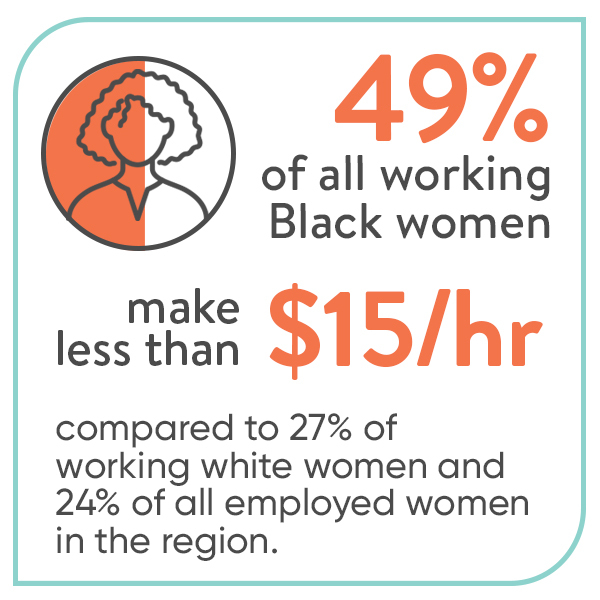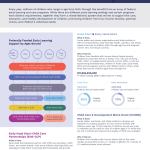Economic mobility for Black Americans has shown notable signs of improvement in recent years, particularly for those born into low-income families, as highlighted by a recent Opportunity Insights study. The data reveals that while the racial income gap between Black and white Americans has narrowed, disparities remain due to widening class gaps among white populations. This transformative shift in economic prospects for Black Americans points to a potential reconfiguration of American socioeconomic dynamics, where intergenerational mobility is now more pronounced for younger cohorts. Moreover, the findings underscore the importance of community resources and familial support in enhancing economic outcomes for marginalized groups. As society grapples with these changes, understanding the nuances of Black Americans’ economic prospects becomes crucial in fostering a more equitable future.
The landscape of upward mobility for African Americans has evolved, revealing optimistic trends for those hailing from economically disadvantaged backgrounds. Recent research illuminates the varying degrees of success in bridging class gaps and addressing the historical challenges faced by this community in achieving financial security. As disparities remain, the conversation shifts towards the significance of fostering environments that encourage prosperity and equality of opportunity. Insights into the factors contributing to these shifts, such as family wealth and community investment, paint a broader picture of racial economics in America. Tracking these developments highlights the complexities surrounding economic advancement for Black citizens and the societal efforts necessary to support their progress.
Understanding Economic Mobility for Black Americans
Economic mobility for Black Americans has witnessed significant improvements, as recent studies highlight. Research from Opportunity Insights demonstrates that children of low-income Black families are experiencing better economic prospects compared to previous generations. This shift marks an essential part of the ongoing narrative on Black Americans’ economic prospects, particularly as the study indicates a narrowing racial income gap. The convergence of income levels between Black and white Americans born into poverty suggests that these communities are benefiting from enhanced access to employment and educational resources.
However, while the overall trend appears positive, it is crucial to analyze the intricacies of these changes. The study underscores a simultaneous widening of class gaps, especially among white Americans. This dual development emphasizes the complex reality of economic mobility, as significant strides in earnings for Black Americans occur alongside stagnant or declining incomes for poorer white communities. It illustrates that improving economic conditions for one demographic does not necessarily equate to an equitable uplift across all groups.
Impact of Community and Neighborhoods on Economic Prospects
The research conducted by Opportunity Insights highlights the profound influence of community environments on economic mobility. Areas with strong parental employment rates significantly correlate with better economic outcomes for children, regardless of their racial background. This reinforces the idea that community dynamics play a crucial role in shaping the economic futures of low-income Black Americans. By examining these factors, the researchers reveal that a thriving community can produce ripple effects benefiting all its residents, thereby improving overall economic mobility.
Moreover, the opportunity to grow up in neighborhoods where work is prevalent has far-reaching benefits for children. The study indicates that moving to such neighborhoods at a young age is associated with higher earnings later in life. This insight emphasizes the importance of early-life conditions and social networks that arise from a community with higher employment rates. It also suggests that efforts to enhance community employment could serve as a powerful strategy to combat the racial income gap and foster greater intergenerational mobility among Black Americans.
Class Gaps vs. Racial Gaps in Economic Opportunities
The emerging narrative of growing class gaps alongside shrinking racial income gaps paints a nuanced picture of economic mobility in America. The findings from Opportunity Insights reveal that while Black Americans are seeing improved economic outcomes compared to previous generations, the wealth gap between low-income and high-income white communities is expanding. It raises important questions about the nature of economic opportunities and whether improving conditions for certain groups inadvertently increases disparities for others. In essence, a rising tide may not lift all boats if the economic structures in place disproportionately benefit one demographic over another.
In addressing these challenges, researchers advocate for targeted policies that not only uplift marginalized communities but also address the widening class gaps that threaten economic stability. A comprehensive approach to intergenerational mobility must recognize the interconnectedness of race and class, ensuring that solutions address the systemic issues contributing to inequality. By focusing on both the racial and class dimensions of economic opportunity, stakeholders can forge a more equitable path forward that benefits everyone.
The Role of Policy in Shaping Economic Outcomes
Policy plays a crucial role in shaping the economic landscape and influencing the mobility of Black Americans. As the Opportunity Insights study indicates, access to quality education, employment opportunities, and community resources can significantly impact the economic trajectories of individuals. Policymakers must consider how social programs, tax structures, and local investments can create a more equitable environment for all residents, particularly those from low-income backgrounds. Effective policy interventions can help bridge the gap between racial and class disparities in economic mobility.
Furthermore, dedicated efforts to dismantle systemic barriers remain critical in fostering equal opportunities. This includes addressing discriminatory practices in hiring and education, as well as investing in infrastructure that supports economic growth in marginalized neighborhoods. Enhancing access to affordable housing, healthcare, and educational resources will not only benefit Black Americans, but will also bolster the collective economic health of communities across the board. By placing emphasis on inclusive policy-making, we can promote a more sustainable economic environment.
Historical Context of Racial and Economic Mobility
The historical context of racial and economic mobility remains essential to understanding the progress made by Black Americans today. Analysis of past policies and socioeconomic conditions reveals persistent barriers that have long impeded economic advancement. For instance, regions with historical ties to slavery and segregation tend to exhibit lower levels of intergenerational mobility compared to others. This historical backdrop provides insight into why certain communities have thrived economically while others continue to struggle, further complicating the narrative around racial and class mobility.
Moreover, recognizing the historical context allows for a more nuanced approach to current policies aimed at enhancing economic mobility. It becomes evident that the legacies of systemic racism and economic disenfranchisement must be addressed head-on through targeted interventions. Understanding the historical obstacles faced by Black Americans can inform contemporary practices, ensuring that policies effectively dismantle the entrenched barriers that affect intergenerational mobility. By learning from the past, stakeholders can craft strategies that genuinely promote equitable economic opportunities for future generations.
Economic Data and Identifying Trends in Mobility
Analyzing economic data is vital to understanding the trends in mobility among Black Americans. The data presented by Opportunity Insights reflects significant shifts in economic outcomes over the past several decades. By utilizing comprehensive tax and census records, researchers provide a clearer picture of where disparities exist and how they are changing over time. Identifying these trends allows policymakers and community leaders to target areas in need of intervention and support, enhancing the effectiveness of economic policies.
Moreover, this data-driven approach enables a deeper exploration of the factors influencing economic mobility. From education levels to employment rates, understanding the multi-faceted nature of these statistics helps to paint a clearer picture of progress and setbacks. By continuously monitoring and analyzing economic data, stakeholders can adapt their strategies, ensuring that they address the specific needs of communities most affected by the racial income gap and class disparities. This evidence-based framework creates a sustainable path toward improving economic mobility for all.
Future Outlook for Economic Mobility in America
Looking forward, the future of economic mobility in America rests on a combination of ongoing research, policy adaptability, and community engagement. As the Opportunity Insights study demonstrates, positive changes can occur within a relatively short timeframe, showcasing the potential for upward mobility for Black Americans. However, this potential also necessitates vigilance against the widening class gaps that threaten overall economic stability. It is essential to foster environments that not only support economic growth but also promote inclusivity and equal access.
Additionally, community engagement plays a pivotal role in shaping the future landscape of economic mobility. By empowering local leaders and enhancing grassroots efforts, communities can tailor initiatives that address their unique challenges. Educational programs, job training, and affordable housing initiatives are just a few ways in which communities can directly influence their economic fate. Building bridges between government, nonprofit organizations, and community groups will be key to ensuring that progress is sustained and that all citizens have the opportunity to thrive.
Educational Outcomes and Economic Mobility
The intersection of education and economic mobility is critically important when examining the prospects for Black Americans. Education serves as a fundamental predictor of economic success, providing the skills and knowledge necessary for higher earnings and job stability. The Opportunity Insights study highlights that educational resources must be equitably distributed to ensure that Black children have the same opportunities as their peers in more affluent communities. Access to quality education is thus essential in bridging the gap between economic disparities.
Moreover, initiatives aimed at improving educational outcomes can facilitate greater economic mobility. Programs such as mentorship, scholarships, and after-school tutoring can significantly impact the future of Black youth by equipping them with the tools needed to navigate a competitive job market. Investment in education should be viewed not only as a means of enhancing individual prospects but also as a strategy for promoting broader economic growth and reducing systemic inequality. Ensuring equal access to quality education ultimately lays the foundation for a more just economic future.
Community Engagement and Local Initiatives
The role of community engagement is critical in advancing economic mobility for Black Americans. Local initiatives aimed at fostering collaboration between residents and institutions can lead to transformative changes within neighborhoods. By mobilizing community members, addressing local concerns, and creating tailored programs, these initiatives can combat the barriers that perpetuate economic inequality. Engaging communities in their economic development can help create sustainable solutions that resonate with the specific needs of residents, thereby enhancing overall economic prospects.
In addition, strengthening networks within neighborhoods can bolster support systems that encourage upward mobility. Community programs that focus on economic literacy, job placement, and entrepreneurship can empower residents to take control of their economic futures. Collaborations with local businesses and educational institutions can further enrich these efforts by providing practical resources and opportunities for career advancement. Ultimately, ensuring that communities have a voice in shaping their economic destiny is paramount to achieving lasting change and closing the racial and class gaps in economic mobility.
Frequently Asked Questions
How are economic mobility prospects for Black Americans changing?
Recent research from Opportunity Insights reveals that economic mobility prospects for Black Americans have improved, particularly for those born into low-income families. A comparison of two cohorts, Black millennials born in 1992 and Black Gen Xers born in 1978, shows significant increases in average income, with millennials earning an inflation-adjusted $21,030 at age 27 compared to $19,420 for Gen Xers. This suggests shrinking racial income gaps, as Black individuals are experiencing greater upward mobility.
What does the Opportunity Insights study say about intergenerational mobility among Black Americans?
The Opportunity Insights study highlights that intergenerational mobility for Black Americans is witnessing positive changes, with those born in 1992 enjoying better economic outcomes compared to their counterparts from 1978. The reduced rate of poverty among Black millennials – dropping from a 14.7% likelihood of remaining in poverty to 4.1% – signifies a shift toward improved economic prospects and opportunities for the younger generation.
What impact do class gaps have on the economic mobility of Black Americans?
The Opportunity Insights study indicates that while racial income gaps are decreasing, class gaps are widening. This means that although economic mobility for Black Americans is improving, disparities between low-income and high-income individuals, particularly among white Americans, are increasing. Thus, while Black Americans are seeing progress, there remains a challenge as class-based economic divides grow.
How does regional variation affect the economic mobility of Black Americans?
Economic mobility among Black Americans significantly varies by region. According to the Opportunity Insights study, Black individuals in the Southeast and Midwest have made the largest monetary gains compared to those in other areas. This points to the importance of geographical factors in determining economic prospects for Black Americans and underscores the need for targeted policy interventions in areas with persistent poverty.
What are the implications of the racial income gap for Black Americans’ economic mobility?
The racial income gap remains a hurdle for economic mobility among Black Americans, although improvements are noted in recent years. The difference in average earnings between Black and white individuals, which decreased from $12,994 for Gen Xers to $9,521 for millennials, shows that while mobility is increasing, systemic barriers persist that contribute to ongoing economic disparities.
What role do neighborhood conditions play in the economic mobility of Black Americans?
Neighborhood conditions are crucial for the economic mobility of Black Americans, as evidenced by the Opportunity Insights study. Areas with higher rates of adult employment correlate with better economic outcomes for all residents, including Black children. The findings suggest that growing up in communities with strong parental employment positively impacts long-term earnings potential, emphasizing the significance of childhood environments on future economic success.
| Key Findings | Details | Implications | |
|---|---|---|---|
| Economic prospects for Black Americans born poor improved recently. | Reported earnings for Black millennials born in 1992 averaged $21,030 compared to $19,420 for Gen Xers born in 1978. | ||
| Widening income gap between low- and high-income white Americans. | Low-income white Gen Xers earned an average of $27,680, which has grown lesser compared to the rise observed in high-income whites. | ||
| Geographical shifts are influencing economic mobility. | Regions such as the Southeast and Midwest show the most improvement for low-income Black children. | ||
| Racial disparities persist but reduced for Black millennials. | Racial earnings gap fell from $12,994 for Gen Xers to $9,521 for millennials. | ||
Summary
Economic mobility for Black Americans has seen significant improvements, particularly for those from low-income backgrounds. Recent research indicates that while these economic prospects are brightening for younger generations, racial disparities remain, albeit reduced compared to previous decades. Understanding these changes highlights the complex interplay of geography, class, and opportunity in shaping the future economic landscape for Black Americans.


